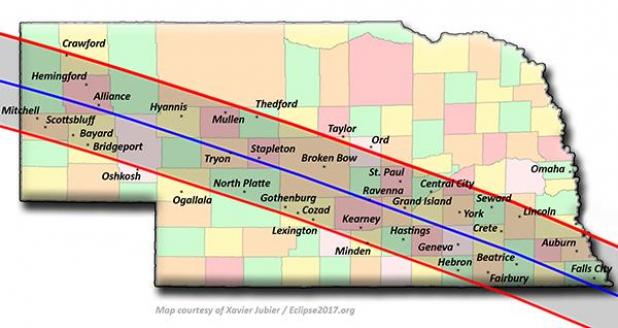
The Monday, Aug. 21, solar eclipse path of totality spans the United States from the west coast to the east coast. The path in Nebraska is pictured. Everywhere within the shaded area will experience a total eclipse, with the longest amount of time, about two and a half minutes, being along the center line. The entire country outside the path of totality will experience a partial eclipse. — Map courtesy of Xavier Jubier | Eclipse2017.org
Historic total solar eclipse nears
The United States will experience a rare and historic celestial event Monday, Aug. 21, when a total solar eclipse crosses the nation. Beginning in Lincoln Beach, Oregon, at 10:15 a.m. PDT and ending about an hour and a half later near Charleston, South Carolina, at 2:48 p.m. EDT, the total eclipse will follow a 70-mile-wide course, the path of totality, from coast to coast.
Holyoke is not far at all from the path of totality, but unless residents travel, they will see only a partial eclipse. Oshkosh, Nebraska, is just outside the path, while North Platte, Nebraska, is within it. Many communities that are on the center of the path are hosting special events, including Nebraska’s Alliance, Tryon, Stapleton and Grand Island. Along that center line, the total eclipse will last for about two and a half minutes. The further a location is from the center of the path, the shorter its viewing will be.
State and national parks all along the path have events planned to celebrate and view the phenomenon across the nation. For information on such opportunities in Nebraska, visit http://outdoor
nebraska.gov/eclipse/. National park information can be found at www.nps.gov.
The last total eclipse visible from the contiguous United States was nearly four decades ago. February 26, 1979, one was visible in five states in the Pacific Northwest. Of course, there are different kinds of eclipses, including partial and annular solar eclipses, as well as lunar eclipses. Solar eclipses happen more often, but are visible in only a small area. The less frequent lunar eclipses, however, are visible from over half the earth.
All of North America will — weather permitting — experience at least a partial eclipse Aug. 21, but the path of totality is limited to the United States, which hasn’t happened since 1778.
The last total eclipse that crossed the entire continent was June 8, 1918. This year’s total eclipse will pass through 14 states total: Oregon, Idaho, Wyoming, Montana, Nebraska, Iowa, Kansas, Missouri, Illinois, Kentucky, Tennessee, Georgia, and North and South Carolina.
While the 70-mile-wide path of totality is relatively narrow, about 12.2 million people live within the area. About two-thirds of the U.S. population live within one day’s drive of the path, and many are planning to make the trek. It’s no wonder, since the next time a total solar eclipse will be visible in the United States will be April 8, 2024, and it won’t be nearly as close to Holyoke.
Alex Young, a solar scientist at NASA Goddard Space Flight Center said, “If you have an opportunity to see this — take it. You will not be disappointed.”
The full article is available in our e-Edition. Click here to subscribe.
